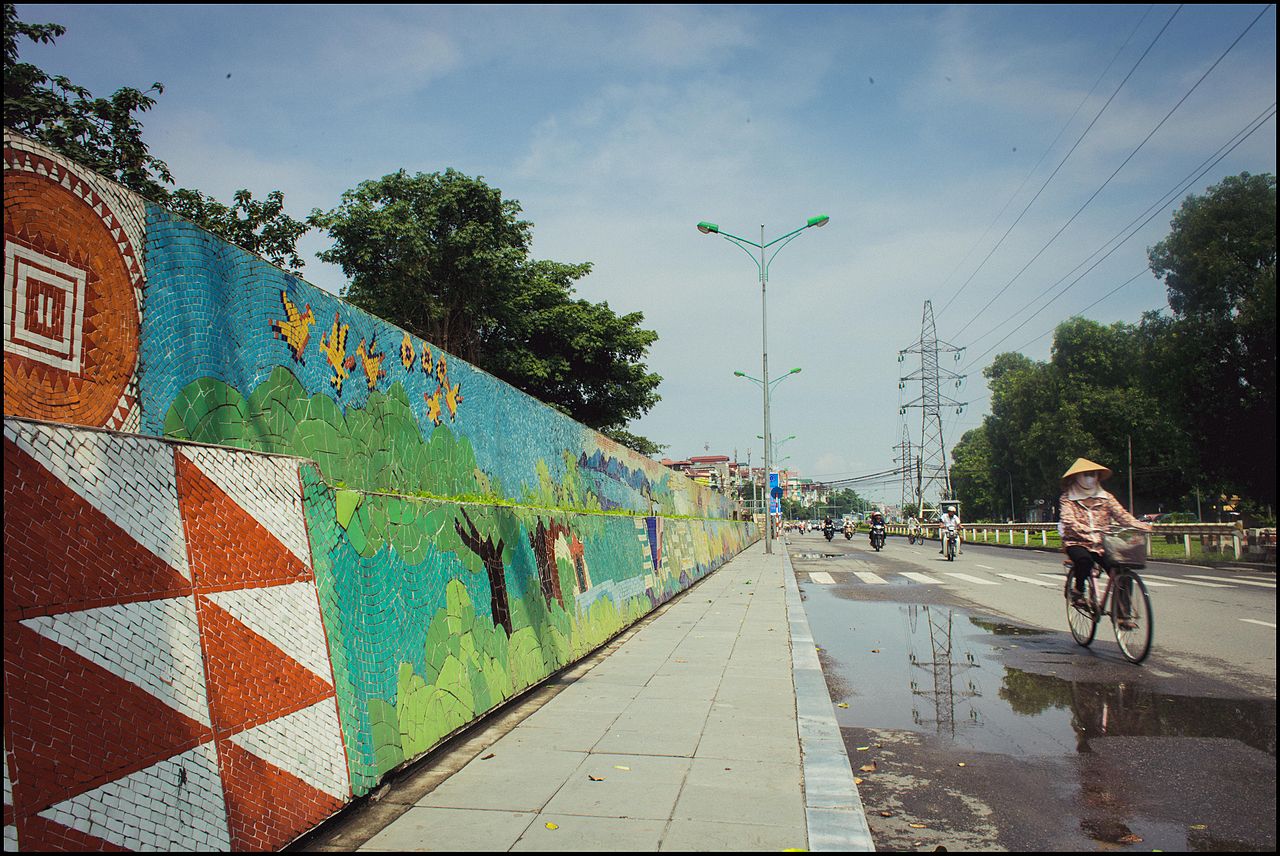Have you ever wondered where would the largest ceramic mosaic on the planet be? If you were thinking in Europe or in America, you’d be wrong because it’s located far out of any beaten tourist track, in a country not so widely known for its mosaic heritage. The largest ceramic mosaic art on the planet is in Hanoi, Vietnam.
How could this be, that such a massive art project graces a wall in the far-eastern country, by using a traditional Mediterranean technique? Well, first of all, we have to recognize the fact that this is a mosaic made out of ceramic tiles and that clay has always been an important expressive device in the East. Mixed with the fact that it is a relatively new project, we come to the conclusion that the Hanoi Mosaic Mural is the brainchild of the wonderfully eclectic contemporary times.

Hanoi Mosaic Mural – Photo by Newone
The Birth of the Largest Ceramic Mosaic
Conceived in the mind of journalist Nguyễn Thu Thủy, the wall was meant to transform the Red River dike wall around the city of Hanoi and give a range of grey, boring barriers new life. After it won the architecture contest, her idea was realized and the construction of this massive applied work of art began in 2007, to be completed in 2010 for the city’s 1000th-anniversary celebration. The project gained a lot of support internationally from different foundations, donors and artists, and it was followed until finished with undivided attention. Its creator involved 35 professional artists from Vietnam, but also creatives from 10 countries around the world and over 500 Vietnamese and international children and art students as well. Today, it stands as one of the greatest attractions in the city of Hanoi.
The mosaic art itself was made from Bát Tràng ceramic tesserae, produced in a neighboring village famous for its porcelain by over 100 traditional artisans. Each tile measures only 3 x 3 cm and every square meter of the wall mosaic contains about 1000 of tesserae. Spanning across about 4 km (2.5 mi) in length, the mosaic reaches a height of almost 1m, while its contents represent the most interesting images inspired by the history of Vietnam, its historic cultures and dynasties in conjunction with contemporary artworks, representations of Hanoi and works of children. The final result is the explosion of colorful images of dragons, fish, birds, boats and various decorative patterns.
After its completion, in October 2010, Guinness World Records committee reviewed and recognized the Hanoi Ceramic Mosaic Mural as the largest one in the entire world.

Hanoi Mosaic Mural – Photo by Erwin Verbruggen from Amsterdam, The Netherlands
How a Mosaic Mural Changed Hanoi
If we review the creation process of this public artwork, it becomes apparent that the cultural significance of the Hanoi Mosaic Mural might surpass the importance of its impressive dimensions. This huge wall piece is, in fact, the first public collective work of art in Vietnam, and it dared to cover a wall which is said to be about 800 years old!
Knowing the fact that this long-term impoverished country, despite being built on several highly developed cultures and rich in artifacts, could not invest too much into public art, the creation of this mosaic wall might be considered a cornerstone in the recent history and development of Vietnam. The overseeing organization for mural implementation was let by Nguyễn Thu Thủy and it also offered mosaic classes to both children and adults, thus contributing to the changing climate in the city and consequently, the country. The international nature of the mosaic wall also emphasizes creativity and art as a point of connection rather than seclusion and fear of what is foreign, something the Vietnamese seem to have overcome.

Hanoi Mosaic Mural via Wikimedia Commons
Contemporary Mosaic Wall – Reflecting the Culture
Even the visual content of the mural supports this fact. The long mosaic is divided into 21 sections and it shows different scenes and styles inspired by the rich Vietnamese art history. It’s a special kind of a narrative that incorporates the old and the new, the abstract and the representational, all harmonized to fit the country’s eclectic cultural identity.
Walking, driving or riding a bike along this very special mosaic wall is not only a colorful ride down the history lane. It also represents the hope for the better future, because this, once ugly, channel fence stands out from its environment just enough to instill the sense of hope into its spectators. The people are allowed to enjoy a different view, to think about the past and to imagine future, without being compelled to notice the inevitable urban decay. Finally, the technique of mosaic has proven ideal for such a project, since it was able to connect several crucial things – the tradition of local ceramics, extraordinary durability and remarkable expressive potential. Now, the people of Hanoi can look forward to having a colorful decoration in their city in the place of what was once an ugly, vandalized, grey barrier.

Hanoi Mosaic Mural – Photo credit zostel

Hanoi Mosaic Mural via greentangerinehanoi


Image: Hanoi Mosaic Mural Anniversary Dragons – Photo by Newone


1 comment
Nice content